...wanted to have access to the contractors and make it easier to interface with the conveyance contractors,” says Hummel.
| + click to enlarge |
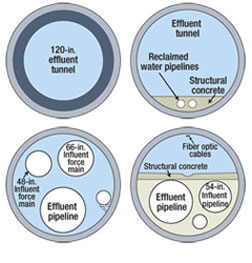 Nancy Soulliard / ENR Source: King County
|
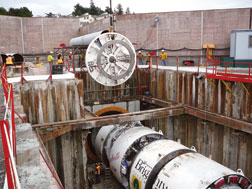 John J. Kosowatz / ENR West tunnel TBM is fitted with cutter head. Tunnel segments are fitted with pipes in differing configurations.
|
Three main contractors now are working at the plant site. Hoffman and Kiewit Pacific are building the plant itself and interfacing with a joint venture of Kenny Construction, Traylor Brothers Inc. and J.F. Shea Construction Co. Inc., which is responsible for the portion of tunnel that ties in with the plant. Hoffman came online in 2004 to help with preconstruction, and holds final responsibility for the site.
Bidding on subcontracts, such as the sitework and the mechanical systems, was slow, says Dave Johnson, project manager with Hoffman. With so much construction in the area, “getting bidders was difficult,” Johnson says. “We struggled to get more than a few. They had to be able to do the work and stretch their bonds out for three to four years. Getting labor hasn’t been a problem, but getting the best workers has been more of a challenge.”
Materials price escalations and the seismic lawsuit forced the county to redesign portions of the project when the design was about 60% complete. During the value-engineering process Hoffman came up with between $60 million and $80 million in savings, Hummel says.
Fluctuations in materials prices has not been too much of an issue, but the county’s cumbersome process to collect on escalation clauses could be masking the problem, says Chris Foss, King County construction manager. “Only one has been exercised and it’s been for fuel,” she adds.
Obtaining large-diameter pipe has also been difficult. “We don’t have a lot of people who can fabricate it,” Foss says. “We found a fabricator in Portland, but delivery has been delayed somewhat.”
|
“Getting the best labor has been more of a challenge.” — DAVE JOHNSON, HOFFMAN CONSTRUCTION
|
Sitework
Protecting the wetlands and nearby Little Bear Creek, a salmon-bearing stream, was Hoffman’s initial focus after mobilization. The contractor formed Alpha Hill, a 350,000-cu-yd landform on the south end of the site to use for spoil storage. “The final height of Alpha Hill varies, depending on how much dirt we need for [stages of] construction,” says Johnson.
After the site was cleared, Hummel says designers and contractors discovered old creek beds following the slope abutting the jobsite, passing through the site and discharging into the creek. After an early rainstorm, “stormwater ate up about half of the site,” says Johnson. Designers staked out an approximate $2-million diversion, sinking a series of dewatering wells to send flows north to the wetland mitigation area. The wetlands filter the water and discharge gradually into the creek, preventing turbidity problems that could affect fish spawning.
“We’re glad we did it that way, or we would have had a huge dewatering problem,” Johnson says.
Currently eight subcontractors are on the project and 32 sub packages have been awarded, he adds. Six tower cranes are being used, two of them mounted on rails for more efficient hoist capacity over a large area, says Johnson.
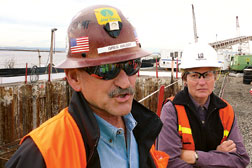 John J. Kosowatz / ENR Jay-Dee’s Hauser, county’s Cochran review West tunnel section by Puget Sound.
|
Wastewater will enter the plant through a force main on the south side of the site and move through headworks and grit chambers before being sent to primary tanks. From there, baseload flows will be sent to a battery of 10 21-ft-deep, 70-ft-long, 28-ft-wide MBR tanks for secondary treatment. Disinfection will be by sodium hypochlorite. Biosolids will be moved to three 60-ft-dia., 61-ft-deep digester tanks, now being built by Kiewit Pacific. Post-tensioning allows relatively thin walls that are 1.5 ft thick.
“The shape and height are chosen so we can covert to thermophyllic digesters and the county can increase capacity in the future,” Johnson says.
Tunnels
Brightwater’s inland location 13 miles from Puget Sound pushed design of a $450-million conveyance system to carry influent to the plant, dispose of treated effluent to the sound and deliver reclaimed water to new customers. The main 13-mile-long tunnel is being built under three contracts with contractors using four soft-ground tunnel-boring machines working in poor soils with high groundwater pressures. Some connectors used microtunneling machines.
“We had to balance the advantages of using only four TBMs and disturbing less of the surface against the difficulty of boring such long tunnel sections,” says Judy Cochran, conveyance project manager with King County.
Designed by MWH, Broomfield, Colo., and Jacobs Associates, San Francisco, the county awarded the $91.86-million, 21,000-ft West tunnel to a joint venture of Jay Dee Construction, Frank Coluccio Construction Co. and Taisai Corp. It recently began its drive inland from Puget Sound with a Lovat earth-pressure balanced TBM. One of its trickiest tasks—driving only 16 ft beneath a major rail line, was completed last month without any subsidence, says project manager Greg Hauser.
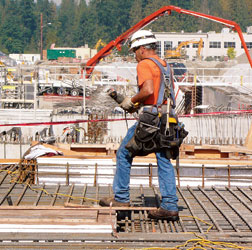 John J. Kosowatz / ENR
|
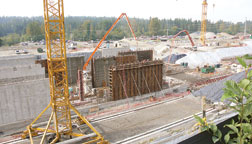 John J. Kosowatz / ENR Primary tanks take shape as mat for bioreactors is placed. MBR system reduced overall footprint by 30%.
|
The $211-million central segment is being built by the joint venture of Vinci/Parsons RCI/ Frontier Kemper with two slurry machines manufactured by Germany’s Herrenknecht AG. Designers specified slurry machines because of poor soils and water pressure expected to reach 8 bar. Its machines are working from one portal, driving an 11,600-ft-long tunnel and 20,100-ft section in opposite directions.
The Kenny/Traylor/Shea joint venture is working under $92-million contract to drive 14,000 ft of tunnel with another EPB Lovat machine. It is expected to finish early next year.
Because of variable soils, King County conducted boring tests every 500 ft prior to design. All machines are progressing at between 150 and 185 ft per week. The contractors are working between 16 and 24 hours per day, with time included to maintain and repair the TBMs. Custom software allows managers to view numerous TBM operating systems and rates of progress in real time, updated every 10 seconds, says Anthony Pooley, project manager for construction manager Jacobs Civil.
“Ten years ago you could not have built this tunnel using these methods,” says Pooley, pointing to advances in tunneling technology that allow for longer drives between portals.
But tunnelers are limited in spoil disposal, even though it is clean, and are constrained by the few number of distant sites that will accept it. Kenny produces up to 1,200 cu yd daily and disposal costs “have increased eight-fold,” says project manager Mark Saylor.

Post a comment to this article
Report Abusive Comment